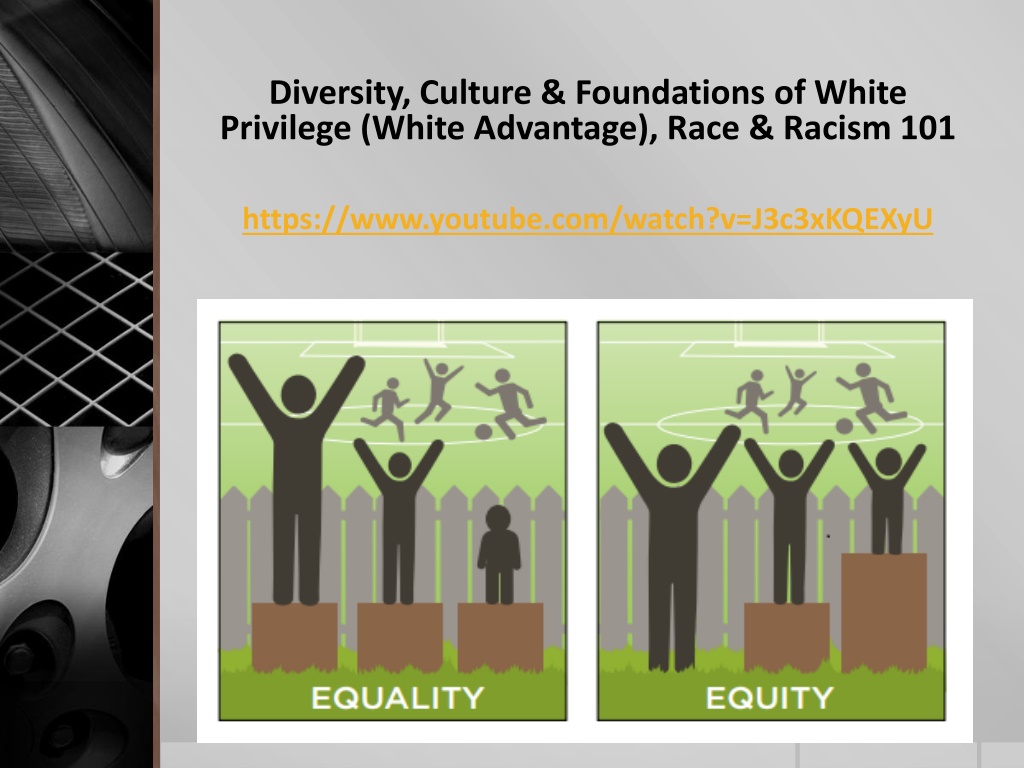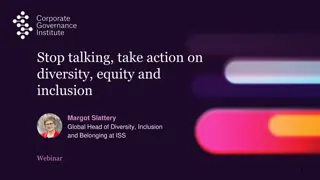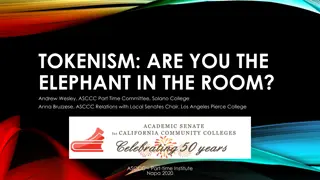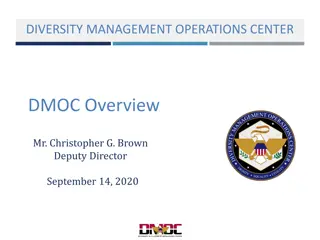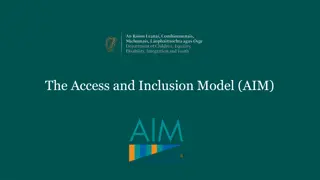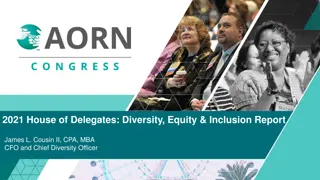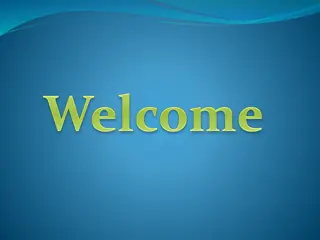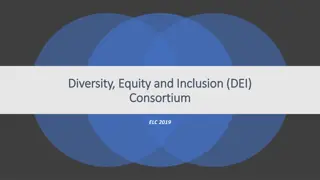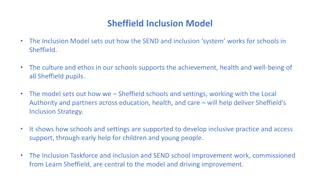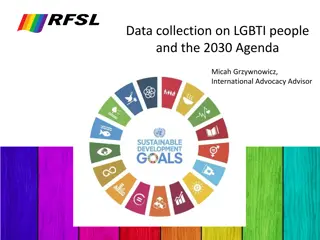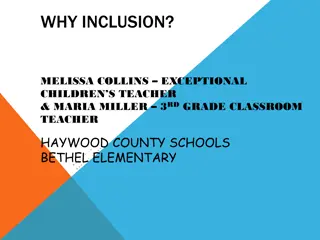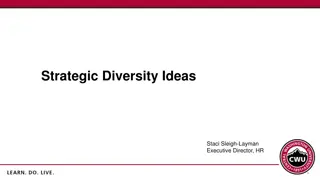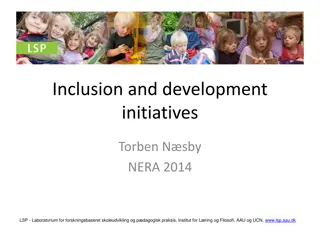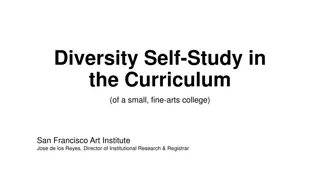Understanding Diversity, Inclusion, and Socialization
Exploring concepts such as diversity, inclusion, and the cycle of socialization is crucial in promoting a more accepting and embracing society. Acknowledging individual differences and engaging with diverse perspectives leads to a richer and more empathetic community, fostering growth and understanding.
Download Presentation

Please find below an Image/Link to download the presentation.
The content on the website is provided AS IS for your information and personal use only. It may not be sold, licensed, or shared on other websites without obtaining consent from the author. Download presentation by click this link. If you encounter any issues during the download, it is possible that the publisher has removed the file from their server.
E N D
Presentation Transcript
Diversity, Culture & Foundations of White Privilege (White Advantage), Race & Racism 101 https://www.youtube.com/watch?v=J3c3xKQEXyU
Transitions and Transformations In reality learning and change are interconnected. Change is not an issue if it makes sense to and is owned by those involved, rather than being arbitrarily imposed. An appreciation that change is a continual process, involving confusion and difficulty, is vital for all learners. It is not change that kills, it is the fear of new knowledge which leads to transformations and transitions that makes us uncomfortable.
Stereotype Threat https://www.youtube.com/watch?v=nGEUVM6QuMg
Cycle of Socialization Bobbi Harro https://www.youtube.com/watch?v=DYCz1ppTjiM The Beginning We have no choice in our initial identity. First Socialization Our families or adults closer to us begin to shape us right after we are born. Actions One decides to go along with or fight the system. The Core of the Cycle Many things keep us in check: fear, ignorance, confusion and insecurity. Institutional & Cultural Socialization Enforcements People who go along with the social norms. People learn their role in society or from stereotypes. 5
Diversity The concept of diversity encompasses acceptance and respect. It means understanding that each individual is unique and recognizing our individual differences. These can be along the dimensions of race, ethnicity, gender, sexual orientations, sexual orientations status, age political beliefs, disabilities or other social identities or ideologies. It is the exploration of these differences in a diversity-relevant, positive and nurturing environment that will and can shift paradigms. It is about understanding each other and moving beyond simple tolerance to embracing and celebrating the rich dimensions of diversity contained within each individual.
Inclusion Inclusion is the active, intentional, and ongoing engagement with diversity in people, in the curriculum, in the co-curriculum, and in communities (intellectual, social, cultural, geographical) with which individuals might connect in ways that increase one s awareness, content knowledge, cognitive sophistication, and empathic understanding of the complex ways individuals interact within systems and institutions.
Culture & Ethnicity The system of integrated patterns of human behaviors that include rituals, rites of passage, language, thoughts, communications, actions, customs, beliefs, values, artifacts and institutions of racial ethnic, religious, or social groups that the members of society use to make meaning of their world and engage in meaningful interactions with one another, and that are transmitted from generation to generation through learning. An ethnic group or ethnicity is a socially defined category of people who identify with each other based on common ancestral, social, cultural or national experience.
Cultural Awareness Individuals explore their own cultural background to uncover unconscious biases that might impact inclusion. Each individual s experience is unique, affected by the level of cultural awareness she or he brings to the awareness process. Once you are aware of your unconscious biases how do you skillfully manage your biases and value differences. People Skills, people with diversity and cultural competence skills are able to create productive and effective relationships with everyone: The goal is not to become best friends with everyone, but treat everyone fairly.
Cultural Competence The ability to relate effectively across lines of cultural difference. Cultural differences are seen as values, beliefs, norms that differ from one's own. If cultural differences are valued, they can lead to richer and better solutions to goals and challenges. If cultural differences are not valued, they often lead to communication breakdowns that impact relationships and progress in race relations.
Discrimination & Prejudice The practice of unfairly treating a person or group of people differently from other people or groups of people. An unfair feeling of dislike for a person or group because of race, sex, religion, etc. A feeling of like or dislike for someone or something especially when it is not reasonable or logical.
Black/White Binary The most pervasive and powerful paradigm of race in the United States is the Black/White binary paradigm. I define this paradigm as the conception that race in America consists, either exclusively or primarily, of only two constituent racial groups, the Black and the White.
Social Justice Adams, Bell and Griffin (1997) define social justice as both a process and a goal. "The goal of social justice education is full and equal participation of all groups in a society that is mutually shaped to meet their needs. Social justice includes a vision of society that is equitable and all members are physically and psychologically safe and secure. It is important to push for the understanding that racism is 'prejudice plus power' and therefore people of color cannot be racist against whites in the United States. People of color can be prejudiced against whites but clearly do not have the power as a group to enforce that prejudice.
Colorblind Ideology Is a Form of Racism? Colorblindness is the racial ideology that posits the best way to end discrimination is by treating individuals as equally as possible, without regard to race, culture, or ethnicity.
Race Race is a group that is treated as distinct in society based on certain characteristics. Because of their biological or cultural characteristics, which are labeled as inferior by powerful groups in society, a race is often singled out for differential and unfair treatment. It is not the biological characteristics that define racial groups, but how groups have been treated historically and socially. Society assigns people to racial categories (White, Black, etc.) not because of science or fact, but because of opinion and social experience. In other words, how racial groups are defined is a social process; it is socially constructed.
Racism Racism is a doctrine or teaching, without scientific support, that does three things. First, it claims to find racial differences in things like character and intelligence. Second, racism asserts the superiority of one race over another or others. Finally, it seeks to maintain that dominance through a complex system of beliefs, behaviors, use of language and policies. Racism ranges from the individual to the institutional level and reflects and enforces a pervasive view, in white dominated U.S. culture that people of color are inferior to whites. Racist beliefs include things like White people are smarter than people of color, or White people make better teachers. Racism can manifest itself in terms of individual behavior through hate crimes, or in institutional behavior through employment discrimination. Racism might manifest in individual language through the use of slurs, or in institutional policy through a school s selection of Eurocentric textbooks.
Institutional, Systemic & Structural Racism https://www.youtube.com/watch?v=36XCiGr8muw&index=8&list=PLteiUBviycNN9fD GMiJUQoPvE91pVFHUy Institutional Racism - is a form of racism expressed in the practice of social and political institutions, as distinct from racism by individuals or informal social groups. It is reflected in disparities regarding criminal justice, employment, housing, healthcare, political power and education among other things. Whether implicitly or explicitly expressed, institutional racism occurs when a certain group is targeted and discriminated against based upon race. Institutional racism can go unnoticed as it is not always explicit and can be overlooked. Systemic Racism - concerns Joe Feagin s (2006) theory that America is founded upon racial oppression and continues to function upon this foundation, and that this oppression by the white manifests itself through all of the US major societal institutions: "As I will demonstrate, systemic racism encompasses a broad range of racialized dimensions of this society: the racist framing, racist ideology, stereotyped attitudes, racist emotions, discriminatory habits and actions, and extensive racist institutions developed over centuries by whites." Structural Racism a system of societal structures that work interactively to distribute generational and historic advantages to groups of people based on race and that produces cumulative, race-based inequalities. This includes laws and policies with unintended consequences based on racialized behavior.
White Privilege (White Advantage) https://www.youtube.com/watch?v=GTvU7uUgjUI&list=PLteiUBviycNN9fDGMiJUQoP vE91pVFHUy White skin privilege is not something that white people necessarily do, create or enjoy on purpose. Unlike the more overt individual and institutional manifestations of racism described above, white skin privilege is a transparent preference for whiteness that saturates our society. White skin privilege serves several functions. First, it provides white people with perks that we do not earn and that people of color do not enjoy. Second, it creates real advantages for us. White people are immune to a lot of challenges. Finally, white privilege shapes the world in which we live the way that we navigate and interact with one another and with the world. In his 1935 Black Reconstruction in America by W.E.B. first described the Psychological Wages" of whiteness: It must be remembered that the white group of laborers, while they received a low wage, were compensated in part by a sort of public and psychological wage. They were given public deference and titles of courtesy because they were white. They were admitted freely with all classes of white people to public functions, public parks, and the best schools. The police were drawn from their ranks, and the courts, dependent on their votes, treated them with such leniency as to encourage lawlessness. Their vote selected public officials, and while this had small effect upon the economic situation, it had great effect upon their personal treatment and the deference shown them. White schoolhouses were the best in the community, and conspicuously placed, and they cost anywhere from twice to ten times as much per capita as the colored schools. The newspapers specialized on news that flattered the poor whites and almost utterly ignored the Negro except in crime and ridicule.
White Privilege (Advantage) Continued WHITE PRIVILEGE: THE PERKS WHITE PRIVILEGE: THE ADVANTAGES When I cut my finger and go to my school or office s first aid kit, the flesh- colored Band-Aid generally matches my skin tone. When I stay in a hotel, the complimentary shampoo generally works with the texture of my hair. When I run to the store to buy pantyhose at the last minute, the nude color generally appears nude on my legs. When I buy hair care products in a grocery store or drug store, my shampoos and conditioners are in the aisle and section labeled hair care and not in a separate section for ethnic products. I can purchase travel size bottles of my hair care products at most grocery or drug stores. My skin color does not work against me in terms of how people perceive my financial responsibility, style of dress, public speaking skills, or job performance. People do not assume that I got where I am professionally because of my race (or because of affirmative action programs). Store security personnel or law enforcement officers do not harass me, pull me over or follow me because of my race.
White Privilege: The World View When I am told about our national heritage or civilization, I am shown that people of my color made it what it is. Related, the schools that I attend or have attended use standard textbooks, which widely reflect people of my color and their contributions to the world. When I look at the national currency or see photographs of monuments on the National Mall in Washington, D.C., I see people of my race widely represented and celebrated.
Whiteness As Property The origins of Whiteness as Property lie in the parallel systems of domination of Black and Native American peoples out of which were created racially contingent forms of property and property rights. Whiteness and property share a common premise, a conceptual nucleus to exclude. White identity became the basis of radicalized privilege that was ratified and legitimated in law as a type of status property. After segregation was overturned, whiteness as property evolved into a more modern form through law s ratification of the settled expectations of relative white privilege as a legitimate and natural baseline (Harris,1993).
White Supremacy By white supremacy I do not mean to allude only to the self- conscious racism white supremacist hate groups. I refer instead to a political, economic, and cultural system in which whites overwhelmingly control power and material sources, conscious and unconscious ideas of white superiority and entitlement are widespread, and relations of white dominance and non-white subordination are daily reenacted across a broad array of institutions and social settings (Ansley, 1997, p.592).
Racial Microaggressions Commonplace verbal or behavioral indignities, whether intentional or unintentional, which communicate hostile, derogatory, or negative racial sights and insults Microinsult (Often Unconscious) Microassault (Often Conscious) Microinvalidation (Often Conscious) Microexclusion (Often unconscious) Behavioral/verbal remarks or comments that convey rudeness, insensitivity and demean a person s racial heritage or identity Explicit racial derogations characterized primarily by a violent verbal or nonverbal attack Verbal comments or behaviors that exclude, negate, or nullify the psychological thoughts, feelings or experiential reality of a person of color The omission or lack of presence of people of color in real and symbolic locales that serve to facilitate perceptions of exclusion. Sue, D. W. and colleagues (2007). Racial microaggressions in everyday life: Implications for clinical practice. American Psychologist, 62(4), 271-286. 24
Examples of Racial Microagressions https://www.buzzfeed.com/hnigatu/racial-microagressions-you-hear-on-a- daily-basis?utm_term=.ffe2YyRYG#.cmbWL92Le
Cycle of Liberation Bobbi Harro Getting Ready Waking Up Consciously dismantling and building aspects utilizing new knowledge. When a change happens within oneself. Maintaining This needs to be cultivated and debugged, and modified as need be over time. Reaching Out The Core of the Cycle of Liberation We act differently and see how others react to our new world views. Liberation is the practice of Love! Building Community Creating Change Coalescing Start having active dialogue with others and include others. Creating a new culture and sense of identity. Taking Action! 26
Pluralism Q&A -- Reflections First, pluralism is not diversity alone, but the energetic engagement with diversity. Diversity can and has meant the creation of religious ghettoes with little traffic between or among them. Today, religious diversity is a given, but pluralism is not a given; it is an achievement. Mere diversity without real encounter and relationship will yield increasing tensions in our societies. Second, pluralism is not just tolerance, but the active seeking of understanding across lines of difference: Tolerance is a necessary public virtue. Tolerance is too thin a foundation for a world of differences and diversity proximity. It does nothing to remove our ignorance of one another, and leaves in place the stereotype, the half-truth, the fears that underlie old patterns of division and violence. In the world in which we live today, our ignorance of one another will be increasingly costly. Third, pluralism is not relativism, but the encounter of commitments. The new paradigm of pluralism does not require us to leave our identities and our commitments behind, for pluralism is the encounter of commitments. It means holding our deepest differences, even our religious differences, not in isolation, but in relationship to one another. Fourth, pluralism is based on dialogue. The language of pluralism is that of dialogue and encounter, give and take, criticism and self-criticism. Dialogue means both speaking and listening, and that process reveals both common understandings and real differences. Dialogue does not mean everyone at the table will agree with one another. Pluralism involves the commitment to being at the table with one s commitments.
